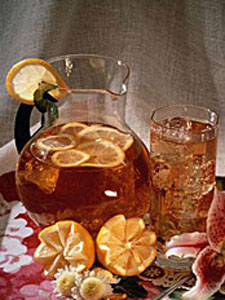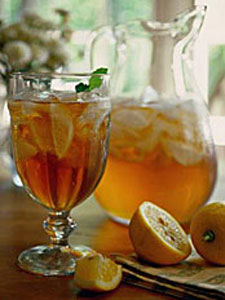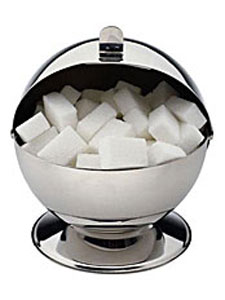Sweet Tea for Valentine's Day



"When I take my sugar to tea, all the boys are jealous of me, 'cause I never take her where the gang goes, When I take my sugar to tea."
Tea connoisseurs gasp at the mention of it. Atkins' followers tremble at the mere thought. At the very least, however, they will all acknowledge that it has a longer tradition in America than nearly all tea-related beverages. If you don't know what I'm referring to, you haven't spent much time in America's South. Deep in Dixie, served everywhere from McDonald's to the classiest of restaurants, the staple beverage on everyone's menu is Sweet Tea. In fact, if you order iced tea in the South without specifying a preference, chances are you'll be served Sweet Tea.
Tea may be "hot" now, but Sweet Tea has been popular in the South for many, many decades. Long before a time you could walk just a few blocks to find a café serving a boiled brew, Southerners were reveling in the sweet taste of this saccharine sensation. Sweet Tea is the Southern version of the "regular" iced tea most Americans are familiar with. It is prepared in the same way as normal iced black tea - with one addition: sugar. Lots and lots of sugar.
The history of Sweet Tea dates back to the 19th century, when Americans first attempted to grow tea in the United States. The area that bore the essential tropical climate conditions for cultivation of the common tea plant, Camillia Sinensis, and that was most similar to the most prolific tea-growing countries, India, China and Sri Lanka, was found on Wadmalaw Island off the shore of South Carolina. Founded by Dr. Charles Shepard, the plantation was later purchased by tea industry giant, Lipton. After relatively little success, Lipton sold the land and the estate became known as the Charleston Tea plantation. Tea grown by this company was sold under the name "American Classic Tea," and was the only tea ever commercially grown in South Carolina, or anywhere else in North America. As an unfortunate side-note, the Charleston Tea plantation's profit margin was considered too narrow to continue operations and was purchased by another tea industry leader, Bigelow, in 2003. Now known as Charleston Tea Gardens, it still remains the only working tea estate in the United States.
Our other main ingredient in Sweet Tea, sugar, was made widely available and affordable in 1846 thanks to Louisiana native Norbert Rillieux, son of a French inventor and a slave mother. The process of widely refining sugar from cane was hazardous and rudimentary, requiring strenuous effort (and was therefore quite costly). Rillieux's contribution was to design a method that took most of the labor out of the refining process. This new technique produced an inexpensive and deliciously pure final product.
The unison of our two ingredients, as legend would have it, occurred in the summer of 1904. The location was the World's Fair in St. Louis. An Indian tea merchant found himself unable to move his product due to the sweltering summer heat. As a desperate (and somewhat sweetly serendipitous) act, he cooled his customers down by putting his tea on ice and adding sugar.
A more accurate story probably goes something like this: In the relatively poor South, most folks could not afford the luxury of the expensive leaf, but found that, when mixing it with sugar (which was plentiful in the South at the time-Louisiana was the country's biggest producers), they had created an inexpensive means of extending the amount of tea. A similar factor was at work in Japan, where the abundance of rice and the relative expense of tea had produced a unique combination we now know as Genmai Cha.
It comes as no surprise that Sweet Tea quickly became part of the culture in the South and remains a lasting legacy, often called the "house wine" of the South.
As a young boy growing up in Dixie, my first exposures to tea accompanied every lunch, with a big, icy glass of Sweet Tea (well, if you believe my family's stories of my mischievous past, then it may have closer to 3 or 4 glasses). As the years went on (and I became a naturalized Yankee), my tastes (and behavior!) matured (slightly!). I began exploring more "gourmet" varieties of tea. Nevertheless, on each sojourn to my native soil, I still insist on having pitchers and pitchers of Grandma Cason's Sweet Tea.
To make Sweet Tea, boil approximately 4 cups of water. After boiling, add double the amount of tea leaves (I recommend a Ceylon) that you would normally use (about two tsp. per glass of tea) and steep as usual (five minutes in most cases). After steeping, add approximately one to two cups (that's right-CUPS!) of sugar while it is still hot. Finally, dilute with an equal amount of cold water and/or ice and let chill (the best Sweet tea is served ice-cold). And don't worry if the final product is not judged sweet enough. You may always sweeten it later, even when chilled, by adding liquid sugar, such as a product called Sugar Shots
Another essential aspect to consider is the quality of your water. Everybody knows that water quality is crucial to make a really good tea. This is especially important with iced teas. Iced tea cannot hide behind the water temperature, unlike hot beverages, which dull your taste buds (so you can't taste how bad that tap water is!). So, when making Sweet Tea, brew respectfully and thoughtfully, with all the grace and hospitality the South is famous for!
With February 14th approaching, I offer this introduction to Sweet Tea as my Valentine, with sugary wishes of love and happiness to all Tea Muse readers. Connoisseurs may scoff, but Sweet tea is a wonderfully refreshing and uniquely American tea treat. So if you're looking for candy from Cupid this year, try putting down the chocolates and pick up an icy sweet cup!
